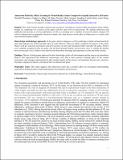Immersion positively affects learning in virtual reality games compared to equally interactive 2d games
Author(s)
Thompson, Meredith; Uz-Bilgin, Cigdem; Tutwiler, M Shane; Anteneh, Melat; Meija, Josephine Camille; Wang, Annie; Tan, Philip; Eberhardt, Richard; Roy, Dan; Perry, Judy; Klopfer, Eric; ... Show more Show less
DownloadAccepted version (398.3Kb)
Open Access Policy
Open Access Policy
Creative Commons Attribution-Noncommercial-Share Alike
Terms of use
Metadata
Show full item recordAbstract
Abstract
Purpose
This study isolates the effect of immersion on players’ learning in a virtual reality (VR)-based game about cellular biology by comparing two versions of the game with the same level of interactivityand different levels of immersion. The authors identify immersion and additional interactivity as two key affordances of VR as a learning tool. A number of research studies compare VR with two-dimensional or minimally interactive media; this study focuses on the effect of immersion as a result of the head mounted display (HMD).
Design/methodology/approach
In the game, players diagnose a cell by exploring a virtual cell and search for clues that indicate one of five possible types of cystic fibrosis. Fifty-one adults completed all aspects of the study. Players took pre and post assessments and drew pictures of cells and translation before and after the game. Players were randomly assigned to play the game with the HMD (stereoscopic view) or without the headset (non-stereoscopic view). Players were interviewed about their drawings and experiences at the end of the session.
Findings
Players in both groups improved in their knowledge of the cell environment and the process of translation. Players who experienced the immersive stereoscopic view had a more positive learning effect in the content assessment, and stronger improvement in their mental models of the process of translation between pre- and post-drawings compared to players who played the two-dimensional game.
Originality/value
This study suggests that immersion alone has a positive effect on conceptual understanding, especially in helping learners understand spatial environments and processes. These findings set the stage for a new wave of research on learning in immersive environments; research that moves beyond determining whether immersive media correlate with more learning, toward a focus on the types of learning outcomes that are best supported by immersive media.
Date issued
2021Department
Massachusetts Institute of Technology. Department of Brain and Cognitive Sciences; Massachusetts Institute of Technology. Program in Comparative Media Studies/WritingJournal
Information and Learning Science
Publisher
Emerald
Citation
Thompson, Meredith, Uz-Bilgin, Cigdem, Tutwiler, M Shane, Anteneh, Melat, Meija, Josephine Camille et al. 2021. "Immersion positively affects learning in virtual reality games compared to equally interactive 2d games." Information and Learning Science, 122 (7/8).
Version: Author's final manuscript